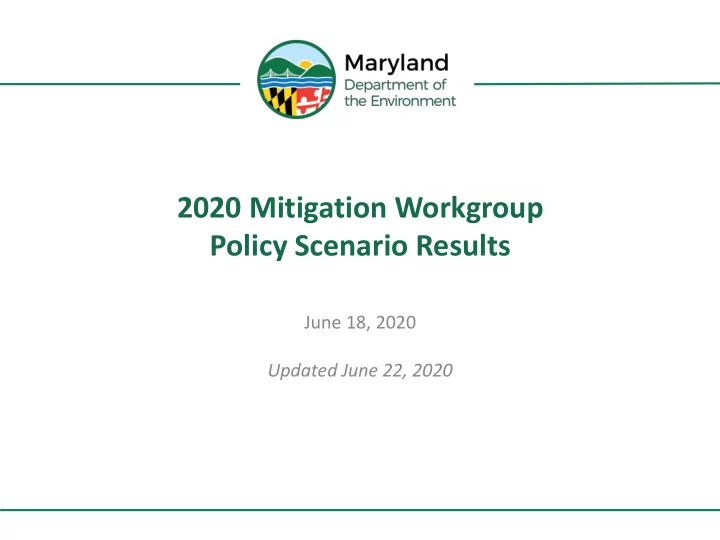

2020 Mitigation Workgroup Policy Scenario Results June 18, 2020 Updated June 22, 2020
Reminder - Process • MDE has reserved a portion of our analysis budget for MWG use. • MWG scenario based on input from NGO MWG members and followup with MWG volunteer group. • Results today are preliminary. • Additional policy scenarios and sensitivity analysis to come later.
Caveats – See Clarification • Modeling a zero-carbon electricity system is challenging, as estimates of future needs & cost of energy storage and other grid enhancements vary dramatically. – EG from Clean Air Task Force: “At high levels of wind and solar energy (> 60% of system energy), “filling the gap” begins to pose serious cost challenges [~~$473 Billion in MD for 100% renew]” https://mde.maryland.gov/programs/Air/ClimateChange/MCCC /MWG/MWG_C2ES_CATF_CARES09172019.pdf – EG from MWG Member Arjun Makhijani: 100% renewable costs ~$400 million more than business-as-usual in 2050; yields net savings across energy system https://mde.maryland.gov/programs/Air/ClimateChange/MCCC /MWG/IEEREnergyAndClimatePlanForMaryland.pdf – See Clarification on IEER Analysis on Following Slide
**NOTE: NEW SLIDE*** Clarification on IEER Analysis • At MWG member Makhijani’s request, the following clarifies the relevant conclusions from IEER’s report: • The data and analysis in Prosperous Renewable Maryland indicate that a renewable energy electricity sector, including all storage and demand response costs (including $1.1 billion in battery storage costs in 2050), providing the same end uses (including mostly electrified transportation and buildings) would be about $4 billion to $7 billion per year cheaper than a business-as-usual electricity sector in the year 2050. A summary of the analysis is in Slide 18 of https://mde.maryland.gov/programs/Air/ClimateChange /MCCC/MWG/IEEREnergyAndClimatePlanForMaryland.p df
Caveats • As E3 will explain, our tools do not explicitly model battery storage and other grid solutions that may be necessary for a ~75% renewable system as envisioned in this scenario. • This may leave some costs unaccounted for. • A number of the measures modeled here are outcomes; policies to accomplish these outcomes would be the next conversation.
Impacts Summary The MWG scenario shows positive economic impacts before 2030, negative after ( results are preliminary ). Large positive health and climate impacts. MD impact relative to 2021 Through 2021 Through Reference Case 2030 2050 Average job impact* + 3,329 job-years - 5,646 job-years GDP Impact** + $ 2.02 billion - $ 16.4 billion Personal Income Impact** + $ 1.97 billion - $ 12.7 billion Public Health Benefit + $ 0.78 billion + $ 5.07 billion (Avoided Mortality)** Climate Change Benefit** + $ 3.36 billion + $ 28.6 billion * Average number of job-years created or sustained each year. ** 2018 Dollars, Cumulative, Net Present Value using 3% discount rate. Climate benefit evaluated using Federal Social Cost of Carbon (2015 Update)
Economic Impacts are Preliminary • MDE & RESI are still debugging the economic model. • Transportation infrastructure costs in these results are drawn from GGRA Draft Plan modeling; updated estimates available shortly. • We’ll provide updated results next month.
Recommend
More recommend